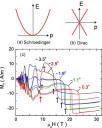The energy E of a bowling ball increases as the square of its velocity (or momentum p). This is also generally true for electrons in solids, which are accurately described by the Schràƒ’¶dinger equation (Fig. 1a). However, in a small set of materials - e.g. bismuth, antimony and graphene - E increases linearly with p (Fig. 1b). To describe this unusual behavior, we resort to the Dirac equation, which has been very successful in describing neutrinos and high-energy electrons. The "Dirac" electrons are predicted to exhibit a host of new electronic states, especially when an intense magnetic field is applied. A group led by Ong and Cava (Princeton) has reported the observation of phase transitions involving the Dirac electrons in bismuth. By monitoring the spins of the Dirac electrons, they observed sharp jumps of the magnetization MT in high magnetic field H (red and black arrows in Fig. 1c). The Dirac electrons come in three "flavors" in bismuth. In low H, each electron exists in one of the flavors. At large H however, all the electrons exist in the three flavors simultaneously. This quantum mechanical behavior (called superposition of states) enables the electrons to stay apart from each other, and thus to lower their total Coulomb energy.

Figure 1 The variation of energy E vs. momentum p for Schràƒ’¶dinger electrons (Panel a) and Dirac electrons (b). Panel (c) shows curves of magnetization MT vs. field H at several tilt angles of H relative to a symmetry axes in bismuth. The jumps (red and black arrows) indicate sharp phase transitions of the Dirac electrons.